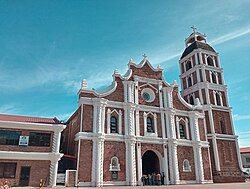| Tuguegarao Cathedral | |
|---|---|
| Saint Peter Metropolitan Cathedral | |
 Cathedral facade in March 2024 | |
Location in Luzon | |
| 17°36′49″N121°43′50″E / 17.613592°N 121.730503°E | |
| Location | Tuguegarao City |
| Country | Philippines |
| Denomination | Roman Catholic |
| History | |
| Dedication | Saint Peter |
| Dedicated | 1761, 2014 |
| Architecture | |
| Functional status | Active |
| Architect(s) | Antonio Lobato |
| Architectural type | Cathedral |
| Style | Barn-style Baroque |
| Groundbreaking | 1761 |
| Completed | 1768 |
| Specifications | |
| Materials | Sand, gravel, cement, mortar, steel and bricks |
| Administration | |
| Province | Tuguegarao |
| Metropolis | Tuguegarao |
| Archdiocese | Tuguegarao |
| Deanery | St. Peter the Apostle |
| Clergy | |
| Archbishop | Ricardo Lingan Baccay |
| Rector | Franklin Manibog |
Saint Peter Metropolitan Cathedral, commonly known as Tuguegarao Cathedral, is an 18th-century Baroque Roman Catholic church located along Rizal Street, Barangay Centro 10, Tuguegarao City, Philippines. The church, originally built by Dominican friars, is the seat of the Archdiocese of Tuguegarao and is considered one of the largest churches in the Cagayan Valley. A historical marker bearing a brief history of the church was installed in 1982 by the National Historical Institute, precursor of the National Historical Commission of the Philippines.
















